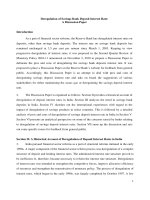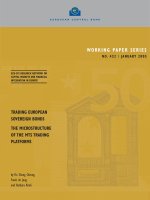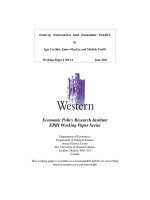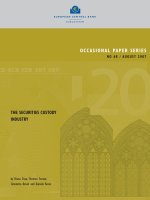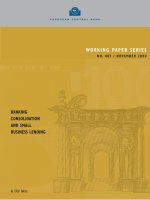Forecasting Credit Portfolio Risk - Discussion Paper Series 2: Banking and Financial Supervision No 01/2004 pot
Bạn đang xem bản rút gọn của tài liệu. Xem và tải ngay bản đầy đủ của tài liệu tại đây (326.98 KB, 44 trang )
Forecasting Credit
Portfolio Risk
Alfred Hamerle
(Universität Regensburg)
Thilo Liebig
(Deutsche Bundesbank)
Harald Scheule
(Universität Regensburg)
Discussion Paper
Series 2: Banking and Financial Supervision
No 01/2004
Discussion Papers represent the authors’ personal opinions and do not necessarily reflect the views of the
Deutsche Bundesbank or its staff.
Editorial Board: Heinz Herrmann
Thilo Liebig
Karl-Heinz Tödter
Deutsche Bundesbank, Wilhelm-Epstein-Strasse 14, 60431 Frankfurt am Main,
Postfach 10 06 02, 60006 Frankfurt am Main
Tel +49 69 9566-1
Telex within Germany 41227, telex from abroad 414431, fax +49 69 5601071
Please address all orders in writing to: Deutsche Bundesbank,
Press and Public Relations Division, at the above address or via fax No +49 69 9566-3077
Reproduction permitted only if source is stated.
ISBN 3–935821–82–4
Abstract
The main challenge of forecasting credit default risk in loan portfolios is forecasting the
default probabilities and the default correlations. We derive a Merton-style threshold-value
model for the default probability which treats the asset value of a firm as unknown and uses a
factor model instead. In addition, we demonstrate how default correlations can be easily
modeled. The empirical analysis is based on a large data set of German firms provided by
Deutsche Bundesbank. We find that the inclusion of variables which are correlated with the
business cycle improves the forecasts of default probabilities. Asset and default correlations
depend on the factors used to model default probabilities. The better the point-in-time
calibration of the estimated default probabilities, the smaller the estimated correlations. Thus,
correlations and default probabilities should always be estimated simultaneously.
Keywords: asset correlation, bank regulation, Basel II, credit risk, default correlation,
default probability, logit model, probit model, time-discrete hazard rate
JEL classification: C23, C41, G21
Non-technical Summary
Forecasting credit portfolio risk poses a challenge for the banking industry. One important
goal of modern credit portfolio models is the forecast of the future credit risk given the
information which is available at the point of time the forecast is made.
Thus, the discussion paper “Forecasting Credit Portfolio Risk“ proposes a dynamic concept
for the forecast of the risk parameters default probabilities and default correlations. The
results are based on an extensive empirical analysis of a data set provided by Deutsche
Bundesbank which contains financial statements for more than 50,000 German firms and a
time period from 1987 to 2000.
Important results of this paper are:
1. The inclusion of macroeconomic risk drivers improves the forecast of default probabilities
considerably. We included the macroeconomic variables business climate index,
unemployment rate and systematic growth in new orders of the construction industry.
2. We find that a large part of co-movements can be attributed to lagged risk drivers. Thus,
default rate or loss distributions can be forecasted given the values of the lagged risk drivers.
3. The model allows default probabilities to be forecasted for individual borrowers and to
estimate correlations between those borrowers simultaneously. We show that asset and default
correlations depend on the point in time calibration of the default probabilities. In addition a
simultaneous estimation eases the validation of default probabilities. Thus, default
probabilities and correlations should never be derived separately from each other.
4. The model is an empirical application of the model which is used for the calibration of risk
weights by the Basel Committee on Banking Supervision. Hence, we are able to compare the
estimated parameters from our model and Basel II directly.
Nichttechnische Zusammenfassung
Die Prognose von Kreditausfallrisiken stellt eine zentrale Herausforderung für Kreditinstitute
und Finanzdienstleister dar. Ein wichtiges Ziel moderner Kreditrisikomodelle ist die Prognose
zukünftiger Kreditrisiken auf Basis der im Prognosezeitpunkt zur Verfügung stehenden
Information.
Vor diesem Hintergrund präsentiert der Diskussionsbeitrag “Forecasting Credit Portfolio
Risk“ ein dynamisches Konzept zur gemeinsamen Prognose der zentralen Risikoparameter
Ausfallwahrscheinlichkeit und Ausfallkorrelation. Die empirischen Untersuchungen in dieser
Arbeit basieren auf der Unternehmensbilanzdatenbank der Deutschen Bundesbank.
Wichtige Ergebnisse des Diskussionsbeitrags sind:
1. Die Berücksichtigung von makroökonomischen Einflußgrößen verbessert signifikant die
Güte der Prognose von Ausfallwahrscheinlichkeiten. Als makroökonomische Einflußgrößen
wurden der Ifo-Geschäftsklimaindex, die Arbeitslosenquote und die Auftragseingänge der
Baubranche verwendet.
2. Ausfallwahrscheinlichkeiten und Ausfallkorrelationen können durch zeitverzögert
wirkende Risikofaktoren erklärt werden. Resultierende Verlustverteilungen können deshalb
bei Kenntnis der Ausprägungen der Risikofaktoren prognostiziert werden.
3. Der Modellansatz erlaubt erstmals die simultane Ermittlung von Ausfallwahrscheinlich-
keiten und Ausfallkorrelationen. Mit der Point-in-Time-Kalibrierung der Ausfallwahrschein-
lichkeiten nehmen die geschätzten Korrelationen ab. Des Weiteren erleichtert die simultane
Schätzung die Validierung der Ausfallwahrscheinlichkeiten. Korrelationen und
Ausfallwahrscheinlichkeiten sollten deshalb nicht getrennt voneinander ermittelt werden.
4. Das Modell entspricht dem des Baseler Ausschusses für Bankenaufsicht. Die geschätzten
Parameter können deshalb unmittelbar mit den Basel II Vorgaben verglichen werden.
Content
1 Introduction 1
2 Modeling default probabilities 3
3 Modeling correlations 8
4 Empirical Analysis 12
4.1 Data 12
4.2 Model-estimation for one risk segment 14
4.3 Model-estimation for multiple risk segments 19
4.4 Forecasting default probabilities 23
4.5 Forecasting the default rate distribution 24
5 Summary 27
Appendix 27
References 28
- 1 -
1 Introduction
The main challenge of forecasting credit default risk in loan portfolios is forecasting the
default probabilities and the default correlations. They are input parameters to a variety of
credit risk models like CreditMetricsä, CreditRisk+, CreditPortfolioManagerä or
CreditPortfolioViewä. For outlines of these models see Gupton et al. [1997], Credit Suisse
Financial Products [1997], Crosbie/Bohn [2002] and Wilson [1997a, 1997b].
The main direction of modeling credit risk has its origin in the seminal model of Merton
[1974, 1977] and Black/Scholes [1973]. Extensions of the approach are described in Black
and Cox [1976], Merton [1977], Geske [1977], Longstaff and Schwartz [1995] or Zhou
[2001]. In this model it is assumed that a default event happens if the value of an obligor’s
assets falls short of the value of debt. Generally speaking, one of the model’s major
shortcomings is the assumption of available market prices for the asset value. This is not
usually valid for retail or small and medium-sized obligors.
Chart 1 displays West German insolvency rates for the years 1980 to 2000. Insolvency rates
are frequently taken as proxies for default rates. It can be seen that the rates fluctuate over
time. An important object of modern credit risk management is the forecast of future credit
risk given the available information at the point of time at which the forecast is made.
Forecasting Credit Portfolio Risk
*
*
We would like to thank Dr. Stefan Blochwitz, Dr. Klaus Düllmann and Dr. Daniel Rösch for
stimulating discussions.
- 2 -
0
0.002
0.004
0.006
0.008
0.01
1980 1985 1990 1995 2000
year
insolvency rate
Chart 1: Insolvency rates of West Germany
In the present paper we use a model to forecast default probabilities and estimate default
correlations based on the threshold model described above. The default probability measures
the probability of an obligor’s assets falling short of a threshold. In addition, asset correlations
are modeled as a measure of co-movement of the asset values of two obligors. Default
correlations can then be derived analytically.
Our approach differs from existing studies on forecasting default probabilities (such as Escott/
Glormann/ Kocagil [2001], Falkenstein [2000] and Shumway [2001]) and estimating default
correlations (like Dietsch/ Petey [2002], Gupton/Finger/Bhatia [1997] and Lucas [1995]) in
several ways and therefore leads to new important results. Firstly, we find that a large part of
co-movements can be attributed to lagged risk drivers. Thus, default rate or loss distributions
can be forecasted, given the values of the lagged risk drivers, and estimation uncertainty can
be reduced. Secondly, the model we employ allows default probabilities to be forecasted for
- 3 -
individual borrowers and to estimate correlations between those borrowers simultaneously.
We show that asset and default correlations depend on the point in time calibration of the
default probabilities. Thirdly, the model is an empirical application of the model which is
used for the calibration of risk weights by the Basel Committee on Banking Supervision
[2003]. Hence, we are able to compare the estimated parameters from our model and Basel II
directly. As a matter of fact, we find significant differences. Fourthly, we use an extensive
data set provided by Deutsche Bundesbank covering 221,684 observations of corporate
balance sheet and default data. The observation period of 10 years spans more than one
business cycle, which is an important requirement for the estimation of cyclical default
probabilities and correlations.
The next section describes the modeling approach for default probabilities and the third
section describes the modeling approach for asset and default correlations. Section 4 presents
and interprets the empirical results for the data set of Deutsche Bundesbank. Section 5
provides a summary of the results and comments.
2 Modeling default probabilities
The event in which an obligor is unable to fulfill its payment obligations is defined as a
default. The default event for obligor i in the time period t is random and modeled using the
indicator variable
it
y , i.e.
î
í
ì
=
otherwise0
in defaults obligor 1 ti
y
it
- 4 -
( TtNi , ,1 ;, ,1 == ). The default event is assumed to be observable.
In addition, the continuous non-observable variable
it
r is defined, which may be interpreted as
the logarithmic return of an obligor’s assets. For the relationship between
it
r and the default
event
it
y a threshold-value model is assumed. Default is equivalent to the return of an
obligor’s assets falling below a threshold
it
c , i.e.
1=⇔≤
ititit
ycr
( TtNi , ,1 ;, ,1 == ). Implicitly, a further assumption is made that no default has occurred
in previous time periods. Therefore, the conditional default probability given that the obligor
did not default until the beginning of the current time period
(
)
()
itititit
crPyP ≤=== 1
λ
is also called a time-discrete hazard rate.
We now propose a linear panel model which includes time-lagged fundamental,
macroeconomic and statistical risk drivers and a contemporary systematic random effect. The
model can be written as
itttitit
ubfr
ϖβ
++++=
−− 110
'' zx
γ
γγ
γβ
ββ
β
- 5 -
( TtNi , ,1 ;, ,1 == ).
1−it
x denotes a vector of time-lagged obligor-specific risk factors such as the return on equity
of the obligor’s previous year’s financial statement or the number of employees two years
ago. Correspondingly,
1−t
z denotes a vector of systematic risk factors, like the unemployment
rate of the previous year or the money market rate two years ago. The time-lagged risk factors
are known at the point of time at which the forecast is given. The subscript 1−t represents
time lags of one and more periods.
In addition, a contemporary systematic factor
t
f is included which explains the systematic
risk components not captured by the model. Throughout this paper, we assume that
t
f
follows a standard normal distribution.
0
β
,
β
ββ
β
,
γ
γγ
γ
and b are suitably dimensioned parameter vectors. Note that the notation refers to
a particular risk segment such as an industry. It is assumed that the obligors are homogenous
within a risk segment regarding the relevant risk factors and the factor exposures. The
parameters and risk factors are allowed to differ between risk segments like industries.
In practice, the realization of the risk drivers and the default indicator
it
y are observable while
the asset returns of the latent model are not. The link between the risk factors and the
probability of default (PD) is described by a threshold model. Given that default has not
happened before t , one obtains for the conditional probability of default given the realization
of the random effect
t
f (and given the values of the observable factors until time period 1−t )
- 6 -
()
(
)
()
()
ttit
ttit
ttitit
it
ttititit
ttititttit
fbF
f
bfc
uP
fcrP
fyPf
~
'
~
'
~~
,,
''
,,
,,1,,
110
11
110
11
1111
+++=
÷
ø
ö
ç
è
æ
−−−−
≤=
≤=
==
−−
−−
−−
−−
−−−−
zx
zx
zx
zx
zxzx
γ
γγ
γβ
ββ
β
γ
γγ
γβ
ββ
β
β
ϖ
β
λ
,
where
()
ϖββ
00
~
−=
itit
c ,
ϖβ
ββ
ββ
ββ
β
−=
~
,
ϖγ
γγ
γγ
γγ
γ
−=
~
and
ϖ
bb −=
~
and
()
.F denotes the
distribution function of the error term
it
u . Since the threshold
it
c cannot be observed, we
restrict the intercept to
0
~
β
.
Different assumptions about the error distribution function
()
.F lead to different models for
the probability of default. In the empirical analysis we use the logistic distribution function
(logit model) which leads to
()
(
)
(
)
(
)
ttitttitttit
fbfbf
~
'
~
'
~
~
exp1
~
'
~
'
~
~
exp,,
11011011
+++++++=
−−−−−−
zxzxzx
γ
γγ
γβ
ββ
βγ
γγ
γβ
ββ
βββλ
,
whereas the standardnormal distribution function
()
.Φ (probit model) leads to
()
(
)
ttitttit
fbf
~
'
~
'
~
~
,,
11011
+++Φ=
−−−−
zxzx
γ
γγ
γβ
ββ
ββλ
.
- 7 -
Note that the probit model is assumed by the Basel Committee on Banking Supervision
[2003] in its Internal-Rating-Based approach in order to calculate the regulatory capital (see
Finger [2001]).
Since we do not know the value of
t
f when the forecast is made we have to calculate the
(expected)
unconditional probability of default given by
()
()
()
ttttittit
dfffbF
~
'
~
'
~~
,
11011
ϕβλ
ò
∞
∞−
−−−−
+++= zxzx
γ
γγ
γβ
ββ
β
,
where
()
()
(
)
2
5,0exp21
tt
ff −=
πϕ
denotes the density function of the standard normal
distribution.
The Parameters
0
~
β
,
β
ββ
β
~
,
γ
γγ
γ
~
and b
~
can be estimated by the maximization of the expected
value of the Likelihood
(
)
bL
~
,
~
,
~
,
~
0
γ
γγ
γβ
ββ
ββ
with respect to the distribution of the random effect
t
f
over all obligors and periods of the data set:
(
)
[
]
(
)
(
)
(
)
()
()
.
~
'
~
'
~~
1
~
'
~
'
~~
~
,
~
,
~
,
~
11
1
11
0
11
0
0
∏
ò
∏
=
∞
∞−
=
−
−−−−
ú
ú
û
ù
ê
ê
ë
é
ú
û
ù
ê
ë
é
+++−+++=
=
T
t
t
I
i
t
y
t
tit
y
t
tit
dfffbFfbF
bLE
itit
ϕββ
β
zxzx
γ
γγ
γβ
ββ
βγ
γγ
γβ
ββ
β
γ
γγ
γβ
ββ
β
This equation contains
T
integrals which can be solved approximately using adaptive Gauss-
Hermite-quadrature (Pinheiro/ Bates [1995] or Rabe-Hesketh/ Skrondal/ Pickles [2002], pp.
5- 9). It follows from the general theory of Maximum-Likelihood estimation that the estimates
exist asymptotically, are consistent and asymptotically normal distributed (Davidson/
MacKinnon [1993], pp. 243 et seq.).
- 8 -
3 Modeling correlations
Asset correlation for one risk segment
The correlation coefficient between the latent variables
it
r and
jt
r of two obligors i and
j
is
called asset correlation
(
)
jtit
rr ,
ρ
:
()
(
)
()
()
()
()
()
()
()
[]
()
()
()
()
()
()
()
.
,
,
,
22
2
22
2
22
2
2222
it
it
t
it
tt
jtit
jttitt
jttitt
jttitt
jtit
jtit
jtit
uVarb
b
uVarb
fVarb
uVarb
ffEb
uVarbuVarb
ubfubfE
ubfVarubfVar
ubfubfCov
rVarrVar
rrCov
rr
ϖ
ϖ
ϖ
ϖϖ
ϖϖ
ϖϖ
ϖϖ
ρ
+
=
=
+
=
=
+
=
=
++
++
=
=
++
++
=
==
We assumed that
it
u and
jt
u have the same distribution. If we assume the logistic
distribution the variance of
it
u and
jt
u equals 3
2
π
and the asset correlation is
()
()
()
3
~
~
3
,
22
2
2
2
2
π
πϖ
ϖ
ρ
+
=
+
=
b
b
b
b
rr
jtit
,
whereas if we assume the standardnormal distribution the variance of
it
u and
jt
u equals 1
and the asset correlation is
- 9 -
()
1
~
~
,
2
2
+
=
b
b
rr
jtit
ρ
.
Asset correlation for multiple risk segments
Sometimes it is plausible to assume that the default probabilities are driven by different risk
factors for different obligors, i.e. obligors belong to different risk segments. Let obligor
i
belong to risk segment l and obligor
j
to risk segment m . The model for the return on
obligor
i ’s assets is
)()()()(
)(
1
)(
)(
1
)(
)(
0
)(
''
l
it
ll
t
l
l
t
l
l
it
l
l
l
it
ufbr
ϖβ
++++=
−−
zx
γ
γγ
γβ
ββ
β
,
while the model for the return on obligor
j
’s assets is:
)()()()(
)(
1
)(
)(
1
)(
)(
0
)(
''
m
jt
mm
t
m
m
t
m
m
jt
m
m
m
jt
ufbr
ϖβ
++++=
−−
zx
γ
γγ
γβ
ββ
β
.
The correlation
(
)
)()(
,
m
jt
l
it
rr
ρ
between the latent variables
)(l
it
r and
)(m
jt
r of two obligors is:
- 10 -
()
(
)
()
()
()
()
()
()( )
[]
()
()
()
()
()
()
()
()
.
,
,
,
,
2)(2)(2)(2)(
)()()()(
2)(2)(2)(2)(
)()()()(
2)(2)(2)(2)(
)()()()()()()()(
)()()()()()()()(
)()()()()()()()(
)()(
)()(
jt
mm
it
ll
m
t
l
t
ml
jt
mm
it
ll
m
t
l
t
ml
jt
mm
it
ll
m
jt
mm
t
ml
it
ll
t
l
m
jt
mm
t
ml
it
ll
t
l
m
jt
mm
t
ml
it
ll
t
l
jtit
m
jt
l
it
m
jt
l
it
uVarbuVarb
ffCovbb
uVarbuVarb
ffEbb
uVarbuVarb
ufbufbE
ufbVarufbVar
ufbufbCov
rVarrVar
rrCov
rr
ϖϖ
ϖϖ
ϖϖ
ϖϖ
ϖϖ
ϖϖ
ρ
++
=
=
++
=
=
++
++
=
=
++
++
=
==
Again, if a logit model is assumed for both risk segments the asset correlation
(
)
)()(
,
m
jt
l
it
rr
ρ
is:
()
(
)
3
~
3
~
,
~
~
,
22)(22)(
)()()()(
)()(
ππ
ρ
++
=
ml
m
t
l
t
ml
m
jt
l
it
bb
ffCovbb
rr
If a probit model is assumed for both risk segments the asset correlation
(
)
)()(
,
m
jt
l
it
rr
ρ
is:
()
(
)
1
~
1
~
,
~
~
,
2)(2)(
)()()()(
)()(
++
=
ml
m
t
l
t
ml
m
jt
l
it
bb
ffCovbb
rr
ρ
.
- 11 -
Default correlation
The default correlation can be derived from the asset correlation. For simplicity we assume
that the obligors
i and
j
belong to the same risk segment and that the default probabilities
can be explained by a probit model. The default indicators
it
y and
jt
y for different obligors i
and
j
are binary random variables taking only the values 0 or 1. For binary random variables
the correlation coefficient
(
)
jtit
yy ,
ρ
for period
t
can be written as
()
(
)
()
(
)
()()()
()()()
11111111
1111111
,1,,1,
,,,,
,
−−−−−−−−
−−−−−−−
−−
−
=
tjttjttittit
tjttittjtit
jtit
yy
zxzxzxzx
zxzxzxx
λλλλ
λ
λ
λ
ρ
,
where
()
11
,
−− tit
zx
λ
and
(
)
11
,
−− tjt
zx
λ
are the unconditional default probabilities and
(
)
111
,,
−−− tjtit
zxx
λ
is the unconditional probability that both obligors i and
j
will default in
period
t
given that neither obligor has defaulted before:
()
()( )
()
ttttjtttittjtit
dfffbFfbF
ϕββλ
~
'
~
'
~~
~
'
~
'
~~
,,
110110111
++++++=
−−
∞
∞−
−−−−−
ò
zxzxzxx
γ
γγ
γβ
ββ
βγ
γγ
γβ
ββ
β
.
If we assume a probit model, it can be shown that
()
()()
()()()
(
)
jtittjttittjtit
rr , , , , ,,,
11
1
11
1
2111
ρλλλ
−−
−
−−
−
−−−
ΦΦΦ= zxzxzxx
- 12 -
where
()
.
2
Φ symbolizes the standardized bivariate normal distribution and
()
.
1−
Φ the
quantile of the standardnormal distribution (Gupton/ Finger/ Bhatia [1997], p. 89). In
conclusion, the default correlation can be derived from the unconditional default probabilities
and the asset correlation of the obligors
i and
j
.
4 Empirical Analysis
4.1 Data
The empirical analysis is based on a data set of Deutsche Bundesbank which originally
contains financial statements for up to 53,280 West German firms and a time period from
1987 to 2000. Compare Scheule [2003] for a more extensive analysis. The data is collected by
Deutsche Bundesbank’s branch offices in order to evaluate the credit quality of firms for
refinancing purposes. The Bundesbank purchases them at the discount rate under its credit
facility. An enterprise is deemed to have defaulted if insolvency proceedings have been
initiated against it. The legal preconditions for the initiation of such proceedings are laid down
in the German insolvency code, i.e. particularly the inability to meet due payments and over-
indebtedness.
In addition, the data set is extended by macroeconomic risk factors for West Germany. They
cover such fields as production, consumption, income, capital markets, employment, import
and export, government activity and prices. All variables are assumed to be stationary. When
they show a trend, rate of returns to the previous year are used. All macroeconomic variables
are lagged by one or two years.
The resulting data set is modified in several ways. The data set is restricted to the years 1991
to 2000 in order to ensure a sufficient number of observations. In addition, only West German
firms are included due to the different economic developments in West and East Germany
during the last decade. The firms are seperated into the industries Manufacturing, Commerce
and Others. Chart 2 shows the Manufacturing industry where the insolvency rates of the
- 13 -
Deutsche Bundesbank data differ from the insolvency rates of West Germany. The default
rate is defined as the ratio between the number of defaulted and the total number of firms.
0
0.004
0.008
0.012
1991 1992 1993 1994 1995 1996 1997 1998 1999 2000
year
insolvency rate
West Germany Deutsche Bundesbank
Chart 2: Default rates of the Manufacturing industry, Deutsche Bundesbank and West
Germany
We assumed that the default rates for West Germany are more representative. Thus, the yearly
default rates are adjusted for each industry according to the ones of West Germany by taking
a random sample from either the defaults or non-defaults of each period. Table 1 shows that
the resulting data set includes 221.684 observations with 1.570 defaults:
- 14 -
Industry Observations Defaults
Manufacturing 88,869 773
Commerce 71,827 406
Others 60,988 391
Total 221,684 1,570
Table 1: Data set Deutsche Bundesbank - number of observations and defaults for
different industries
The data set is divided into an estimation period 1991 to 1999 and the forecast-year 2000.
Table 2 shows the number of observations and defaults of the estimation and forecast periods:
Purpose Period Observations Defaults
Estimation 1991- 1999 195,476 1,391
Forecast 2000 26,208 179
Total 221,684 1,570
Table 2: Data set Deutsche Bundesbank - number of observations and defaults for the
estimation and forecast periods
4.2 Model-estimation for one risk segment
In a first step, we assume that the whole data set represents one risk segment, i.e. the default
probabilities are driven by the same risk drivers and that the asset correlations are the same
for all obligors. For this data set, two logit models with a random effect are estimated:
•
model 1 includes only firm-specific risk drivers and
•
model 2 includes firm-specific risk drivers and a systematic macroeconomic variable.
- 15 -
The highest p-value is 0.0015, i.e. all risk drivers are significant (α=0.05). The random effect
represents an exception which will be explained below. Table 3 displays the estimated
parameters for the two models:
Risk driver
Model 1 (without
macroeconomic risk driver)
Model 2 (with
macroeconomic risk driver)
Intercept -7.7832 -7.8132
ART 0.0062 0.0062
APT 0.0123 0.0124
CRR -0.0324 -0.0326
ETA -0.0162 -0.0160
MAN 0.4045 0.4172
RIE -0.0014 -0.0013
TTT 0.0308 0.0311
GOC . -0.0460
b 0.1205 0.0718
Table 3: Parameter estimates for logit models with random effects, without (model 1)
and with systematic macroeconomic risk driver (model 2)
The risk drivers are the
•
firm-specific ratio of trade accounts receivable to total turnover (ART), ratio of notes and
trade accounts payable to total turnover (APT), the capital recovery rate (CRR), the equity
to assets ratio (ETA), a dummy variable for the manufacturing industry (MAN), the return
on interest expenses (RIE), the transformed total turnover (TTT), and the
•
systematic growth in new orders of the construction industry (GOC).
All risk drivers were checked for economic plausibility. Let us take the equity to assets ratio
as an example. The negative parameter estimate indicates that firms with a higher equity ratio
have lower default probabilities. While most risk drivers show a monotone impact on the
- 16 -
default probabilities, the default rates for small and large firms (low and high total turnover)
are low and for medium firms (medium total turnover) are high. Since a logit model can only
include risk drivers with a monotone impact, we use the default rates of five total turnover
classes and their interpolated values (transformed total turnover) presented in Chart 3 as a risk
driver. We applied a cubic spline-interpolation which uses third degree polynomials. Note that
the interpolated values can be interpreted as the estimated default probability given the value
of the total turnover.
0
0.002
0.004
0.006
0.008
0.01
0 5,000 10,000 15,000 20,000 25,000
total turnover in 1,000 €
estimated default probability
Chart 3: Estimated default probability given the total turnover
The dummy variable for the Manufacturing industry (1: Manufacturing industry, 0: other
industries) indicates that firms of this industry show a higher default probability.
The risk drivers are determined by the use of forward-, backward- and stepwise-selection
methods and are scanned for stationarity. In addition, outliers are adjusted by defining a lower
and an upper boundary for every risk driver. Note that the firm-specific risk drivers are lagged
on average by 1.5 years while the macroeconomic risk driver of model 2 is lagged by one
year.
The risk drivers are calculated in percentages. A more detailed definition of the risk
- 17 -
drivers and descriptive statistics is provided in the appendix. Note that macroeconomic
variables are usually recorded by national institutions and published earlier than the balance
sheets of firms. It should be noted that we do not claim that the risk driver is responsible for
the default probabilities themselves but rather that it represents the respective point in time of
the business cycle.
Chart 4 compares the real default rate with the estimated default rates of model 1 and
model 2. The estimated default rate is the average of the estimated default probabilities.
0
0.002
0.004
0.006
0.008
0.01
1991 1992 1993 1994 1995 1996 1997 1998 1999
year
default rate
real default rate estimated default rate (model 1) estimated default rate (model 2)
Chart 4: Real and estimated default rates for estimation period, model 1 and model 2
The calibration of the estimated to the real default rate is generally better for model 2 (with a
macroeconomic variable) than for model 1 (without a macroeconomic variable). Another
important property of a rating model is the power to discriminate between defaulted and non-
defaulted obligors. The discrimination can be measured by the accuracy ratio (see Sobehart/
Keenan/ Stein [2000]). While the calibration of the two models differ considerably, the
discrimination or accuracy ratio of model 1 (0.630) and model 2 (0.631) is very similar. Note
that systematic macroeconomic risk drivers are the same for all obligors for a given year.

